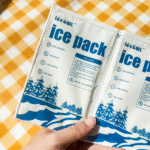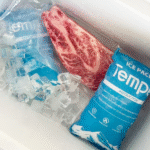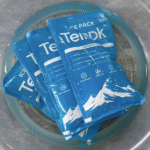How Should Used Dry Ice Packs Be Disposed Of? Are They Environmentally Friendly?
Dry ice is commonly used in shipping perishable goods like food, productos farmaceuticos, and laboratory supplies, but the proper disposal of dry ice packs is often overlooked. En esta guía, we’ll answer how to dispose of them safely, explore their environmental impact, and recommend sustainable alternatives to reduce their carbon footprint.
-
What is the environmental impact of dry ice?
-
How should used dry ice packs be disposed of safely?
-
Son reutilizables?
-
What are the best eco-friendly alternatives to dry ice?
What is the Environmental Impact of Dry Ice?
hielo seco, Hecho de dióxido de carbono sólido (Co₂), is a more environmentally friendly option compared to regular ice. It sublimates directly into gas without leaving any liquid waste. Sin embargo, the environmental impact primarily arises from its production process, which can contribute to greenhouse gas emissions.
Consideraciones clave:
-
Emisiones de co₂: The production of dry ice, while using reclaimed CO₂ from industrial processes, still contributes to carbon emissions if not carefully managed.
-
Sublimación: While CO₂ isn’t a direct pollutant in small amounts, excessive release in confined spaces can be hazardous.
Why Proper Disposal of Dry Ice Is Essential
When handled improperly, dry ice can be hazardous. It sublimes into CO₂ gas, que puede desplazar el oxígeno en espacios confinados, conduciendo a la asfixia. Por lo tanto, it is crucial to dispose of dry ice in a safe, área bien ventilada.
How Should Used Dry Ice Packs Be Disposed of Safely?
Proper disposal ensures safety and minimizes environmental impact. Follow these simple steps to handle dry ice responsibly:
-
Allow Dry Ice to Sublimate: The safest way to dispose of dry ice is by letting it sublimate naturally in a well-ventilated area.
-
Outdoor Disposal: Place dry ice in a spacious, área abierta, lejos de niños y mascotas.
-
Indoor Disposal: si en el interior, ensure the area is well-ventilated with open windows or a fan.
-
-
Evite espacios confinados: Nunca deseche el hielo seco en contenedores sellados., desagües, o espacios cerrados, as the CO₂ buildup could lead to explosions or suffocation risks.
-
Use Protective Equipment: Always wear insulated gloves and goggles to prevent frostbite and burns from the extremely cold temperature of dry ice.
Disposal Method Table
| Disposal Method | Acción recomendada | Potential Hazards |
|---|---|---|
| Allow Sublimation | Leave in a well-ventilated area | None if done correctly |
| Avoid Sealing | Never place dry ice in a sealed container | Risk of explosion due to pressure |
| Outdoor Disposal | Dispose outside in an open area | Ninguno, but ensure safety of children and pets |
| Check Local Regulations | Ensure compliance with local waste disposal guidelines | Risk of legal non-compliance |
Son reutilizables?
Dry ice packs can’t be reused once they have sublimated into gas. Sin embargo, unused dry ice can be stored for future use if placed in an insulated container. This can help slow down the sublimation process.
Are Dry Ice Packs Environmentally Friendly?
Although dry ice has several environmental benefits, such as leaving no liquid waste and being made from reclaimed CO₂, it is not entirely free from environmental concerns:
-
Emisiones de carbono: The process of creating dry ice does contribute to CO₂ emissions, although it is less than other refrigeration methods.
-
Residuos Plásticos: Most dry ice packs are packaged in non-biodegradable plastic, which can add to landfill waste if not properly recycled.
Alternativas sostenibles al hielo seco
Para reducir el impacto ambiental, consider these eco-friendly alternatives:
-
Paquetes de hielo en gel: Non-toxic and reusable, gel packs do not produce emissions and can be an excellent substitute for dry ice in many applications.
-
Materiales de cambio de fase (PCM): These materials can provide long-lasting cold without extreme temperatures, often reusable, and biodegradable.
-
Biodegradable Ice Packs: Some manufacturers offer biodegradable bags that reduce plastic waste.
2025 Trends in Cold Chain and Dry Ice Alternatives
Sustainability in cold chain logistics continues to grow. En 2025, key developments include:
-
Smart Cooling Technologies: Real-time temperature monitoring to ensure better control over dry ice usage, reduciendo el desperdicio.
-
Embalaje ecológico: Growing adoption of biodegradable materials, like plant-based packaging, to complement dry ice usage and reduce the environmental footprint.
Notable Developments in 2025:
-
Materiales de embalaje sostenibles: Increasing use of recyclable and biodegradable materials in cold chain packaging.
-
Improved Dry Ice Production: More energy-efficient methods of creating dry ice are emerging, which help reduce its carbon footprint.
Preguntas frecuentes
q: How can I reuse dry ice?
Dry ice cannot be reused once it has sublimated, but you can store unused dry ice in an insulated container to extend its life for future use.
q: ¿El hielo seco es seguro para el medio ambiente??
While dry ice has a lower environmental impact than many other refrigerants, its plastic packaging contributes to waste. Consider using biodegradable bags or reusing containers to minimize waste.
q: What should I do if I accidentally inhale dry ice gas?
Move to an area with fresh air immediately. Excessive inhalation of CO₂ can cause dizziness, dolores de cabeza, o asfixia.
Conclusión y recomendaciones
The safe and environmentally responsible disposal of dry ice packs is essential. Always dispose of dry ice in an open, well-ventilated area to prevent safety hazards. Consider eco-friendly alternatives like gel packs or PCMs to further reduce environmental impact.
Pasos procesables:
-
Desecho: Ensure that dry ice is left in an open, ventilated space until it sublimates completely.
-
Reciclaje: Check if the packaging is recyclable and dispose of non-recyclable packaging in the appropriate waste stream.
-
Alternativas ecológicas: Explore sustainable cooling solutions like gel packs or reusable containers to reduce your carbon footprint.
Acerca de Tempk
Y tempk, we specialize in innovative, Soluciones ecológicas para la cadena de frío.. Our commitment to sustainability drives us to create energy-efficient products designed to reduce environmental impact while maintaining the highest quality standards. Contact us for tailored cold chain logistics solutions that prioritize both safety and sustainability.























